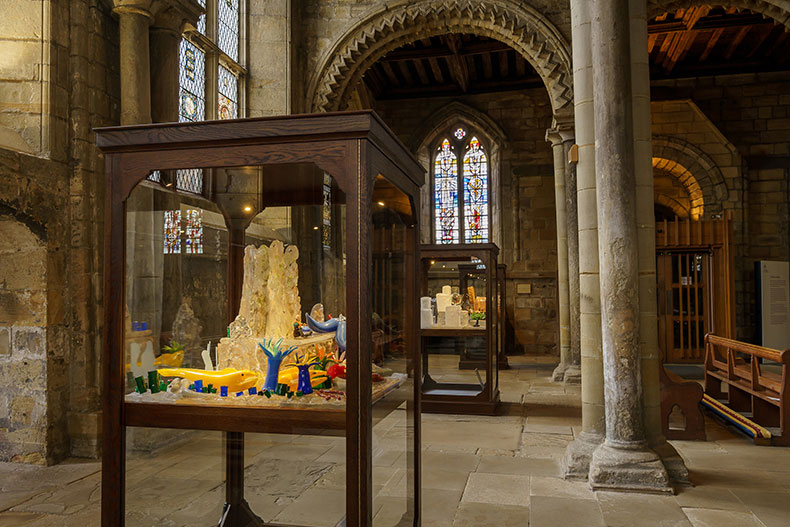The first time most people heard of Britain’s National Glass Centre was in January 2023, when the BBC and the Observer reported that its owner, the University of Sunderland, had decided to close it down within three years. The story of the NGC’s rise and prospective fall is a case study in how applied arts education is being dismantled, year by year, in universities around the country. Such closures will have consequences both for local communities and for the place of the arts in British culture.
The NGC was designed by Gollifer Langston Architects and opened by the current King in 1998. It is located at the mouth of the River Wear, on the site of a former shipyard. Shipbuilding and the production of glass bottles, window glass and tableware were Sunderland’s major industries in the 19th century; the NGC is one of the last physical links with both.
Since 2000, the building’s substantial ‘factory floor’, originally intended for a local glassworks that became insolvent, has housed the university’s glass and ceramics department. The facilities it offers for many glassmaking techniques – blowing, kiln casting, sandblasting, engraving, flameworking, coldworking, waterjet cutting – lend weight to its claim to be the largest department of its kind in Europe.
An institution of many parts, the NGC also contains studio space for professional glass artists to rent, as well as a gallery for temporary shows and for the display of its burgeoning permanent collection, and an exhibition on the 1,300-year history of glassmaking in Sunderland. Staff are in the process of applying for museum accreditation, which will open the way to further expansion – or would have done. There is also a demonstration area where members of the public can watch glass being blown three times a day, and an open studio for flameworking, a form of small-scale hot sculpting with borosilicate glass. The ground floor houses the Northern Gallery for Contemporary Art, which moved there in 2018. Together, the NGC and NGCA are the only two national cultural institutions in Sunderland.
Installation view of Ghost Shop (2022), Ryan Gander. Photo: courtesy the National Glass Centre, Sunderland

But the centre is more than just its facilities: it is the people. There are technicians with years of experience in difficult but essential glassmaking skills. The flameworking studio is run by Brian Jones, a former employee of Jobling Ltd, the Sunderland company which once produced all of the country’s Pyrex. The practice-based PhD introduced by the department in the 1990s was among the first of its kind, not only in the UK but the world. It has enabled many students to develop their work; among them are the conceptual artist Erin Dickson and the Ghanaian artist Anthony Amoako-Attah, who digitally prints and fuses textile patterns in glass. Former academics include the leading historian of Czech glass, Sylva Petrová, and Charles Bray, a ceramicist and glass sculptor who helped to found what is now the Contemporary Glass Society, which represents glass artists in the UK. ‘There’s a library of knowledge,’ says Vanessa Cutler, an artist, academic and former PhD student. Cutler’s work makes use digital designs executed by the waterjet cutter, blurring the boundary between industrial production and handmade object.
Monster Chetwynd’s Life of St. Bede (2022), commissioned by the National Glass Centre and installed at Durham Cathedral

The gallery on the upper floor has hosted groundbreaking exhibitions. For ‘Glass Exchange’ (26 March–11 September 2022), Ryan Gander, Katie Paterson, Pascale Marthine-Tayou and Monster Chetwynd were commissioned to create new installations in glass, using the expertise of the NGC’s makers, to be shown in locations around the North East. Gander, with the help of a team led by Dickson, produced Ghost Shop, the interior of an abandoned betting shop, a sort of ‘phantom’, in transparent glass. It was installed in the city centre, where betting shops and vacant premises abound.
The current show, ‘Confluence’ (until 10 September), explores the relationship between glass and clay through projects by three ceramicists, Bouke de Vries, Andrea Walsh and Andrew Livingstone, which were realised in glass at the centre. The exhibition came about after a conversation between Livingstone, professor of ceramics at Sunderland, and Julia Stephenson, the NGC’s Head of Arts, who both work in the building. The centre is an ecosystem that has enabled the teaching, research and practice of glassmaking techniques and art in glass to flourish in a way that is almost unparalleled in the UK.
The centre, designed by Gollifer Langston Architects, opened in 1998. Photo: travelbild/Alamy Stock Photo.

Unfortunately, the building, a steampunk fantasy in glass, metal and concrete, has long suffered from structural problems, including cracks in the roof and corrosion of the steel frame. Moreover, the NGC, like other arts institutions, has suffered as a result of Brexit and closures during the pandemic, as well as from the high cost of the energy required for its kilns and furnaces. In December 2021, Sunderland Culture, an umbrella company involved in managing the NGC, put out a call for a consultant to advise on ways of improving its ability to generate income. Last year, the university conducted an external review into the building’s viability. As a result, it has decided that it is ‘not in a position’ to pay the ‘multi-million pound investment’ that would be required to sustain it in the ‘longer-term future’. Why Sunderland University has now adopted a more hardline approach than Sunderland Culture a year ago is uncertain. It is clear, however, that the significant funds necessary to keep the NGC afloat are proving hard to come by.
The management’s decision to close the NGC was made, as far as can be ascertained, behind closed doors. After it was made public, they held two staff briefings, but nothing positive seems to have come of them. According to one source, staff have been asked to deflect press enquiries to the communications team.
From the outset, the university seems to have adopted a concerted strategy to present the closure as a fait accompli. It has so far refused to make any commitments as to how much of the NGC will be saved: how many jobs and how much equipment will be retained, whether the contemporary glass collection will be rehoused, and whether any surviving elements will be able to share a single building or will be scattered around the city. The university’s press release floated the possibility that Culture House, a ‘vibrant new city centre location’ under the aegis of the city council that is as yet unbuilt, might be one of several ‘suitable sites’ for the relocation of the NGC. However, at a subsequent council meeting, there was strong opposition to this idea, not least because the building had already been earmarked for other purposes.
Equally unconvincing is the university’s claim that relocating the NGC to the city centre could attract ‘new and larger audiences’. According to its own website, the NGC ‘welcomes over 230,000 visitors per year’, many to participate in its glassmaking courses. Its gift shop and cafe are popular with locals, who can drop in as they walk along the towpath to the beach; it is also a stone’s throw from the seventh-century St Peter’s Church, which still holds fragments of some of the earliest stained-glass windows in Britain, made by glaziers from France. The site of Culture House, on the other hand, is near an A-road in a colourless square flanked by a Holiday Inn, a Primark and the back entrance of an Iceland.
A campaign to ‘Save the NGC’ has been hastily put together by local residents, with tacit support, it is understood, from many of the staff, as well as from the wider glassmaking community. Jo Howell, its organiser, is a freelance photographer who grew up in Sunderland. She represents one of several satellite businesses that work with the NGC. ‘As a child, some of my first experiences of culture were in the Glass Centre, watching people do this wizardry with glass,’ she says. ‘People here are so proud of our glass heritage. Why are they taking it away?’
The NGC’s loss would be a severe blow for the glassmakers of the United Kingdom, and would diminish the cultural life of an already deprived region. Whether the time, will and money can be found to rescue this unique institution remains to be seen.
For more information about the National Glass Centre, click here.



